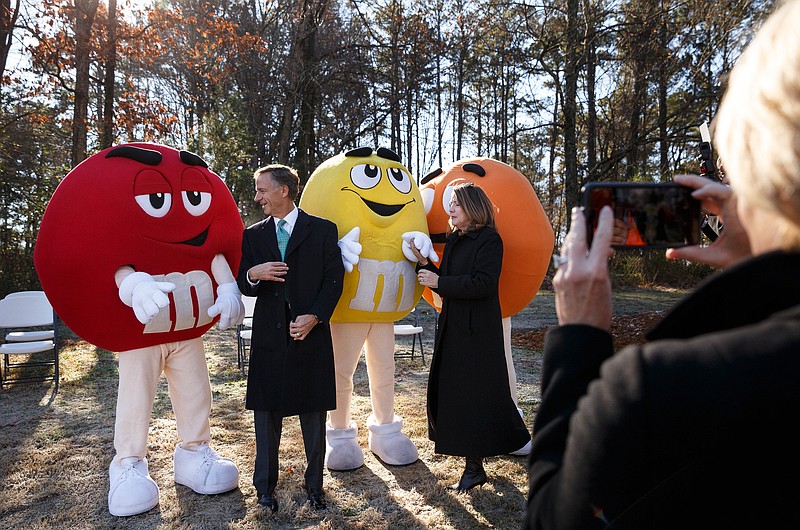Did Mars bring the Great M&M's Controversy on itself?
Last September, in a news release, the candy company heralded the arrival of a purple anthropomorphic M&M's, who was designed to represent acceptance and inclusivity with “her earnest self-expression.”
“There is so much about our new spokescandy that people can relate to and appreciate, including her willingness to embrace her true self,” Jane Hwang, global vice president at Mars Wrigley, said in a statement.
What, in fact, would be the spokescandy’s true self, other than an oval of chocolate covered with a candy shell, the same as fellow M&M's spokescandies Red, Yellow, Orange, Green, Brown and Blue?
Nothing, then, other than what marketers said she would be, an identity Mars called “quirky,” “authentic” and “self-aware.” As a music lover, she also made her social media debut singing “I’m Just Gonna Be Me.”
One could draw conclusions at the time about the marketing, as many did, including Tucker Carlson, the host who is discomforter of the progressive and woke on Fox News and who has lampooned the candies and their images. So now, four months later, quirky Purple and her multi-colored friends are gone, replaced by Maya Rudolph, the biracial comedian who got her start on “Saturday Night Live” and has gone on to star in movies and television sit-coms.
If you had any thought that Fox had lost its influence, as left-leaning media outlets would have you believe, think again. It just killed six candy characters whose genesis goes back nearly 70 years.
Mars earlier this week proclaimed shock that so many people had noticed the subtle and not so subtle changes it made in its spokescandies, saying in a statement that “we weren’t sure if anyone would notice. And we definitely didn’t think it would break the internet.”
For our part, we never noticed the shoe changes on some of the spokescandies (when did they start wearing shoes?), never took note of how many were male and female (apparently there are four males and three females) and never realized the addition of self-aware Purple. We thought they were simply a handful of dancing spokescandies whose true selves would melt in our mouth, not in our hand.
(By the way, we’re not sure if the company still uses the latter slogan, but as late as 2014 it ranked among the top brand taglines in a list of 150 in a study done by Texas Tech University.)
Outside of the true selves of the various M&M's spokescandies, we figured the company had adopted DEI (diversity, equity and inclusion) with its wide variety of candy flavors and colors some years ago.
After all, Mars advertising for the characters representing the candies — which themselves debuted in 1941 — started in 1954 with two talking, anthropomorphic characters — one plain and one peanut — diving into a chocolate swimming pool. The modern computer generated ad campaign with the colorful characters began in 1994.
Over the years, while Tucker Carlson was paying attention to news for grown-ups, various M&M's characters were said to be sardonic, gullible, neurotic, cool and seductive. Apparently, no one ever suggested how intolerant it was to assign the spokescandies feelings when we didn’t know how they really felt inside. But diverse, they were.
And, law. The flavors. Plain and peanut were all poor baby boomers knew. And then in 1989, just as the middle of the Gen-X generation was reaching adulthood, peanut butter M&M's hit the market. Then along came minis, caramel, crunchy mint, white chocolate, cinnamon milk chocolate, mint, strawberry peanut butter, “Wildly Cherry,” chocolate almond, mocha, raspberry almond, triple chocolate, dark chocolate, pretzel, fudge brownie, crispy, almond, white chocolate peanut, crunchy cookie, peanut mix, dark chocolate espresso, strawberry shake, pretzel snowballs, nut brownie, marshmallow crispy treat, white chocolate key lime pie and honey graham. Talk about diverse! And we’re sure there are a lot more flavors we don’t know about.
Why, the company — which has a manufacturing plant in Cleveland, Tenn. — even introduced dulce de leche M&M's for the U.S. Hispanic population in July 2001. However, the flavor never caught on with the population, who preferred the existing flavors. The flavor was discontinued in early 2003.
And, of course, you can order M&M's to say anything you want, penning your own political slogans from far left to far right, so the candies surely are already inclusive.
Now the world that is moved by the demise of spokescandies has some two-and-a-half weeks to await Super Bowl LVII, where Rudolph is to make her bow as M&M's spokeswoman. Of course, one can already find internet suggestions that the whole spokescandies controversy is just a publicity stunt. Indeed, maybe Rudolph will appear in an ad at the head of a conga line of smiling, colorful but thankfully characterless spokescandies all singing “Kum Ba Yah.” And maybe Carlson will go back to railing about illegal immigration or the debt crisis, certainly — to our thinking — two issues worth getting worked up about.
